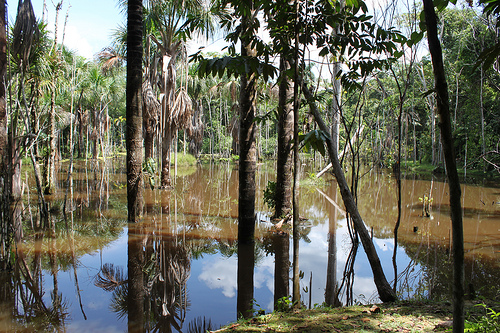This is the second part of a three-part series about water-related problems in the city of Iquitos, Peru. Click here to read the first part.
In our first post we briefly introduced some water-related issues in Iquitos, and later presented the controversy generated by the transnational Conoco Phillips and their exploration and search for hydrocarbons in the Nanay River basin. Speaking on the issue, researcher Gonzalo Tello recently reflected on the actions of Conoco Phillips in his article “El Agua Sagrada” [es] (The Sacred Water):
El problema matriz es que la C P [Conoco Phillips] es una aplanadora ambiental con patente de corso otorgado por el TLC [tratado de libre comercio] con EEUU en el sentido que, como ya les ha sido entregadas las concesiones, con los términos de referencia de un plan de operaciones aprobado por el gobierno peruano (a pesar que tiene varios agujeros serios bajo la línea de flotación ambiental, por los cuales la Historia debería castigar cuando menos moralmente a los responsables), este consorcio petrolero está “blindado” por dicho TLC para ejecutar, sí o sí, sus planes, a cualquier costo, sin que nadie del gobierno se les oponga, bajo penalidad legal vigente del instrumento binacional.
The key issue is that C P [Conoco Phillips] is an environmental steamroller given carte blanche by the FTA [Free Trade Agreement] with the United States in the sense that, as they have already been awarded concessions, with the reference terms of an operations plan approved by the Peruvian government (despite the many serious holes under the environmental waterline that History should punish or at least hold morally accountable), this oil consortium is “protected” by the FTA to execute, no matter what, its plans, at whatever cost, without anyone from the government opposing them, under the current legal penalty of the binational instrument.

“The Nanay River, Loreto, Perú.” Photo by MicroMacroMicro, published on Flickr and used under Creative Commons license (CC BY-NC-ND 2.0)
Regarding the actions of the Regional Government of Loreto surrounding this problem, Darrin Mortenson states [es] the following in this article in Alianza Arkana [es] (Arkana Alliance):
El tema ha sido un tabú político desde que el extractor de EE.UU. ConocoPhillips, sigilosamente se trasladó a la región dos años atrás, a pesar de las leyes del Gobierno Regional de Loreto que prohíben la producción industrial en la naciente del río Nanay.
A pesar de las leyes, el gobierno ha sido complaciente con ConocoPhillips en todo momento desde el 2010. Informantes señalan que una orden de silencio del gobierno y medios de comunicación locales venidos a menos han mantenido el trato fuera del radar público hasta principios de este año.
The issue has been a political taboo since the United States extractor ConocoPhillips stealthily moved into the region two years ago, despite laws of the Loreto's Regional Government that prohibit industrial activity at the mouth of the Nanay River.
Despite these laws, the government has been entirely complacent with ConocoPhillips since 2010. Informants point out that a gag order from the government and the run-down local media have kept this agreement outside of the public radar until the beginning of this year.
With respect to legal efforts by the Comité del Agua (Water Committee) of Iquitos intended to force the publication of impact studies, he adds:
Los resultados se mostrarán siempre y cuando los funcionarios de ConocoPhillips crean que han encontrado petróleo y finalmente presentarán el alcance del proyecto a expertos, activistas y al público en general – algo que el Gobierno regional ha estado desesperadamente, pero al parecer ilegalmente, tratando de evitar.
The results will only be shown if ConocoPhillips’ employees believe they have found oil and will finally present the reach of their project to experts, activists and to the general public – something that the regional Government has been desperately, however seemingly through illegal means, trying to avoid.
It is not only the Regional Government that has an arguable role in these events; according [es] to the weekly publication La Verdad (The Truth) from Iquitos, it is laughable that the Management Committee of the affected area is presided over by “Perúpetro (who gave the concession) and has a Conoco Phillips representative as vice president.”
Moreover, the Congress’ Commission of Andean, Amazonian, Afro-Peruvian Peoples, Environment and Ecology announced [es] plans for a decentralized meeting in Iquitos to analyze the general issue of ConocoPhillips’ operations in the Nanay River basin.
However, the Water Committee wanted to go further and planned [es] a trip to Lima for some of its members as part of a “civic crusade for the defense of the Nanay” with the goal of gaining the public's support and exhausting all obstacles in reaching a dialogue.
Given the limited resources managed by the Committee, they organized a cebichada (fundraiser selling ceviche) to cover some of the costs of the commission to Lima. During this event held [es] on September 15, 2012 in a school in San Agustin, Elizabeth Lozano, spokeswoman for the Colectivo Amazonía (Amazonian Collective) stated: “We ask for the support of citizens that feel committed to the environment and its importance in the future of the Amazon, with the purchase of a ticket worth 10 soles equal to a plate of zúngaro ceviche from the Nanay, the ‘last’ fish of the area that would remain living if we allow high impact activities in its spawning habitat.”
That same day in September, the spokespeople for the Water Committee met [es] with one of Conoco Phillips’ shareholders who was visiting Iquitos. The committee reiterated their position of defense of the Nanay River basin and their demand for cessation of all oil activities in this area. Seamus Finn, the Conoco Phillips shareholder, took note of this and said that he would present the issue in the next shareholder's meeting in New York City on October 5.
Those concerned over the Nanay River now await the results from the actions by representatives of the Water Committee in Lima, on September 24 through 27.







1 comment